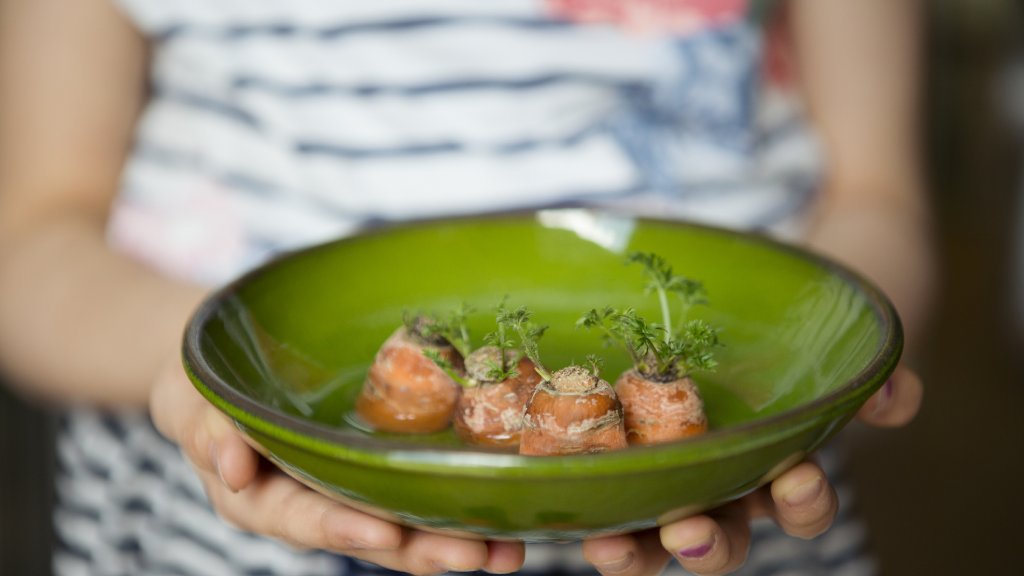Sprouting Carrot Tops With Kids

Let’s grow carrot tops! As one of the easiest plants for a young gardener to grow, carrot tops make pretty houseplants for a sunny window. Their fern-like foliage is beautiful in an outdoor container garden. Eventually, white, lacy flowers will bloom. Growing carrot tops from carrots requires no special equipment, and results will be seen in a matter of days – always a bonus when gardening with kids!
Can You Grow Carrots from Carrot Tops?
Before the above paragraph puts you under the impression that you can regrow a carrot from a carrot top, let’s be clear and say no; a carrot will not grow from a carrot top. Once you’ve cut the taproot (aka the carrot) from the top of this root or any root veggie, the root will not grow again.
What will grow are the greens of the carrot, a fascinating experiment in and of itself. If you are growing carrot tops as a family project, be sure you explain the outcomes of your experiment to your kids before beginning. Otherwise, if someone thinks they’re growing real carrots from carrot tops, they will likely be disappointed.
Going further, it is theoretically possible to grow a carrot top long enough to form seeds, though this may be harder in practice. Remember that if your goal is to get the greens to flower and then produce seeds, carrots are a biennial that produces foliage in the first year and then blooms and seeds in the second year.
This means you would need to keep your carrot tops growing for another year in hopes that they bloom and seed. If you do get seeds, then you can plant them and actually get a full-size carrot.
How to Grow Carrot Tops
Growing carrot tops is a fun project to do with the kids or just for the kid in you. There are several methods by which you can get the greens regrowing, and all of them are relatively successful.
Water Method
The water method will not only regrow carrot tops but also the tops of turnips, radishes, and beets and the bottoms of celery, lettuce, bok choy, and cabbage. The water method is pretty simple.
Sign up for the Gardening Know How newsletter today and receive a free copy of our e-book "How to Grow Delicious Tomatoes".
All you will need is a shallow bowl containing about an inch (2.5 cm) of water and a carrot top about one inch (2.5 cm) thick. Nestle the carrot top, including the greens, into the shallow water. Set the glass in a light but not sunny window and change the water daily. Roots and new leaf growth should appear in as few as three days.
After a few weeks, there should be enough root structure to transfer the carrot top to a container of potting soil where it can continue to grow.
Soil Method
If you want to skip rooting the carrot tops in water, they can be planted directly in potting soil.
- Place the carrot tops in a small container filled with potting soil so the top crown of the carrot is just above the potting medium.
- Keep the soil moist and keep an eye on the tops as you watch them grow into rather lovely, lacy house plants.
Pie Plate Method
For this method of regrowth, you will need either a pie pan or a takeout container.
- Punch a few drainage holes in the bottom of the container and place it on a tray.
- Put a couple of inches (5 cm) of potting soil or marbles into your container and then place the root tops into the soil, cut side down.
- Trim the greens until they are only about half an inch (1.5 cm) long, and place the potted carrot tops in a sunny window.
- Keep the soil consistently moist or regularly add more water to maintain the water level at the top of the marbles, depending on the material you choose.
- New greens or small roots should be visible in a few weeks. The small plants can then be transferred to a pot for further growth.
Newspaper Method
You can also sprout carrot tops in newspapers, paper towels, or even cardboard.
- Soak several layers of your chosen material and lay it in the bottom of a shallow container.
- Place the carrot tops atop the wet medium.
- Keep the material damp, not drenched. You should start to see root development and new foliage in a few weeks.
- Once the new plants have rooted well, you (or your kids) can plant them in the soil.
- The new plants should show growth quickly, and any little gardeners will be delighted with their reward.

Jackie Rhoades began writing for Gardening Know How in 2010.

